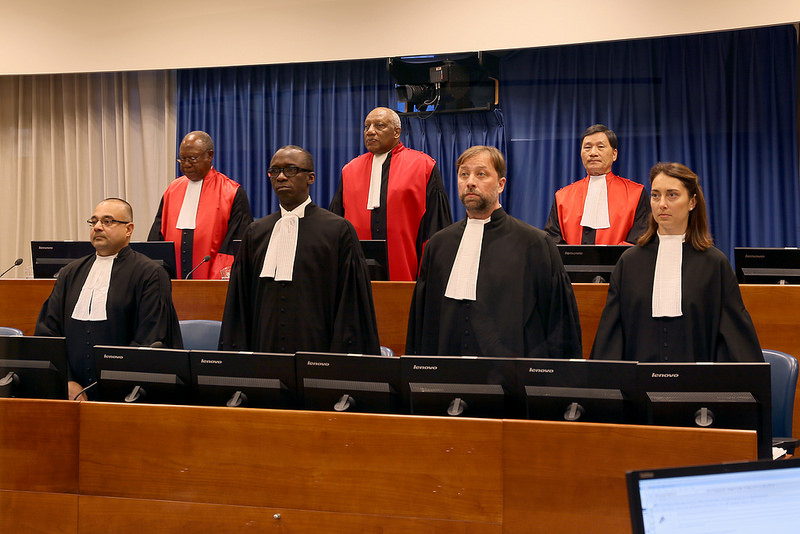Home
NEW TRIAL REPRISES THE FIRST ONE
After the prosecution completed the opening statement, the first witness was called: former employee of the State Security Service, a part of the Federal Secretariat of the Interior. He was the first prosecution witness in May 2008, as the first trial of the former Serbian State Security Service chiefs opened
 Trial Chamber at J. Stanišić i F. Simatović retrial
Trial Chamber at J. Stanišić i F. Simatović retrial At the end of the opening statement at the retrial of Jovica Stanisic and Franko Simatovic, prosecutor Alan Weber indicated the prosecution would prove that various 'Serb forces brutally implemented the joint criminal plan to expel hundreds of thousands of Croats, Muslims and other non-Serbs from areas where they had lived for generations'. In a bid to implement the plan, the Serb forces 'killed, abused, raped and unlawfully detained civilians and prisoners, looting and destroying their property', Weber went on. 'The crimes followed a clear pattern and were committed as part of a bid to implement the goals of a joint criminal enterprise: to create an area under Serb control which would comprise large parts of Croatia and Bosnia and Herzegovina', the prosecutor alleged.
As the defense counsel of the two former Serbian State Security Service chiefs decided not to present their opening statements at the beginning of the trial, and as the accused had waived their right to deliver a statement without making the solemn declaration to tell the truth, the prosecution called its first witness. Just as it was at the beginning of the first trial in April 2008" the first prosecution witness was a former employee of the State Security Service, which was part of the Federal Secretariat of the Interior (SUP), who went in three field trips to Croatia in 1991 in a bid to defuse the interethnic tensions and prevent the conflict from escalating any further. He testified under a pseudonym, RFJ-153, and with image and voice distortion to protect his identity.
The prosecutor started with reading a brief summary of his 'consolidated statement', which includes parts od his evidence at the trial of Stanisic and Simatovic in 2008 and 2010, and his testimony at the trial of Milan Martic in 2006. The summary states that in May 1991 the witness was in Sibenik where he saw about 600 Croats who had fled from Knin. He could see that some of them had been beaten. Later on, he met Jovica Stanisic in Knin on two occasions, learning that a special unit called the Kninjas were being trained in the Knin fortress. The training was run by Captain Dragan . In August 1991, he visited Beli Manastir in Baranja, and encountered Arkan's men, the White Eagles, Badzo's group, also known as the Anti-terrorist Unit, and Frenki's Special Operations Unit. According to the indictment, all those units were established by or on the orders of the Serbian State Security Service.
As the witness explained, there were three levels of cooperation with the Service: 'friendly relations', 'operative relations' and 'collaboration', which was the highest level. The prosecutor then showed the witness a document produced by the Serbian State Security Service (SDB) from 1990, which indicates that Zeljko Raznatovic Arkan had been used for several years by the federal SDB service as its 'operative', but without the knowledge or consent of the Serbian service. Another document from the Serbian SDB, produced in 1991, states that the service was told by some criminals that the Federal SDB had dispatched Arkan to Croatia, with Slobodan Milosevic's consent. Arkan's task was to fire at a police patrol near Obrovac but to make it look as if Croats had fired the shots. Simatovic's defense objected to the prosecution asking the witness to speculate about hearsay evidence, and the judges sustained the objection.
As the hearing drew to a close, Jovica Stanisic's defense started cross-examining the insider from the former Federal Security Service.
Linked Reports
- Case : Stanisic & Simatovic
- 2017-06-13 CLEANSING IN BOSNIA FOLLOWED PATTERN TESTED IN CROATIA
- 2017-06-13 STANISIC AND SIMATOVIC "RESIT TRIAL" OPENED
- 2017-05-19 JOVICA STANISIC WILL RETURN TO THE HAGUE FOR HIS RETRIAL
- 2017-06-15 'RECYCLING' WITNESSES AND QUESTIONS
- 2017-06-27 IRREGULAR FORMATIONS ROLE IN THE WORST PART OF ETHNIC CLEANSING
- 2017-06-28 DID MILOSEVIC CONTROL KNIN AND PALE?
